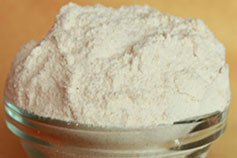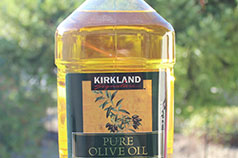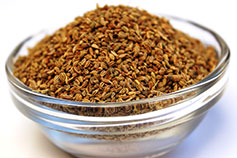
Whole Wheat Flour
Whole wheat flour is obtained by pulverizing whole grain of wheat containing germ (the sprouting part) and the bran (the outer coating). It is used as a main ingredient to make a variety of baking items, such as breads and buns, muffins, cookies and biscuits, pitas, and scones and rolls. Other use of wheat flour is to make pancakes and flat breads like roti and parathas (popular in South Asian counties). Wheat flour is also a main ingredient in making pasta.
Whole wheat flour is a good source of carbohydrates that helps fuel our body. The health benefit reduces when whole wheat flour is processed by removing 40% original wheat flour and replacing it with bleached white flour to commercially produce baked goods, such as breads, pastas, donuts, noodles, cakes, and cookies. Whole wheat flour mixed with other grains, such as oats, grams, and barley (called multigrain flour) is a very good source of proteins, dietary fiber and micronutrients, such as copper, manganese, and magnesium. Indian flat breads such as rotis, parathas, and puris are made at home with whole wheat flour or multigrain flour, which makes the breads really nutritious.
Whole wheat flour is also a good source of proteins. There are 30 different types of proteins in whole wheat flour; however, glutenin and gliadin are the ones responsible for forming an elastic protein called gluten. When the flour is mixed with water and knead to make a dough for baking (or cooking with different methods), glutenin and gliadin absorbs water and comes into contact with each other to form gluten. Gluten protein loses water and becomes hard as it loses moisture during cooking, which gives structure to several baked food and donuts and breads cooked using different methods such as deep frying or cooking on griddle.
Packaged wheat flour has an expiry date on it, so purchase the flour by making sure that it has not expired. After opening the package, wheat flour is best stored in a sealed container in a dry and dark place at room temperature for about 3 months. If kept in refrigerator, it can be used up to 6 months after opening. For longer shelf life of about a year, wheat flour needs to be stored in a freezer.
Whole wheat flour is available in supermarkets and Indian or South Asian grocery stores. It is available at online grocery stores such as amazon.com.
Whole wheat flour is a good source of carbohydrates that helps fuel our body. The health benefit reduces when whole wheat flour is processed by removing 40% original wheat flour and replacing it with bleached white flour to commercially produce baked goods, such as breads, pastas, donuts, noodles, cakes, and cookies. Whole wheat flour mixed with other grains, such as oats, grams, and barley (called multigrain flour) is a very good source of proteins, dietary fiber and micronutrients, such as copper, manganese, and magnesium. Indian flat breads such as rotis, parathas, and puris are made at home with whole wheat flour or multigrain flour, which makes the breads really nutritious.
Whole wheat flour is also a good source of proteins. There are 30 different types of proteins in whole wheat flour; however, glutenin and gliadin are the ones responsible for forming an elastic protein called gluten. When the flour is mixed with water and knead to make a dough for baking (or cooking with different methods), glutenin and gliadin absorbs water and comes into contact with each other to form gluten. Gluten protein loses water and becomes hard as it loses moisture during cooking, which gives structure to several baked food and donuts and breads cooked using different methods such as deep frying or cooking on griddle.
Packaged wheat flour has an expiry date on it, so purchase the flour by making sure that it has not expired. After opening the package, wheat flour is best stored in a sealed container in a dry and dark place at room temperature for about 3 months. If kept in refrigerator, it can be used up to 6 months after opening. For longer shelf life of about a year, wheat flour needs to be stored in a freezer.
Whole wheat flour is available in supermarkets and Indian or South Asian grocery stores. It is available at online grocery stores such as amazon.com.

Salt
Salt is a mineral composed of a chemical compound called sodium chloride. It is essential for human body to regulate fluid balance and to control function of nerves and muscles. Human body cannot produce its own salt and depends on various sources of salt in food for necessary daily intake.
In addition to being just a diet supplement, salt helps in extracting the real flavors of savory as well as sweet dishes. No other seasoning has been found so fulfilling to replace salt. However, the overuse of salt results into a lot of health problems, such as hypertension, heart disease, and strokes. Use salt mildly in your food to you can enjoy its goodness.
In addition to being just a diet supplement, salt helps in extracting the real flavors of savory as well as sweet dishes. No other seasoning has been found so fulfilling to replace salt. However, the overuse of salt results into a lot of health problems, such as hypertension, heart disease, and strokes. Use salt mildly in your food to you can enjoy its goodness.

Water
Coming Soon...

Olive Oil
Olive is one of the oldest known cultivated trees in the world. It is said that Olive trees are being cultivated before the invention of written language. Olive trees are draught tolerant and are native to eastern Mediterranean region. The trees can survive and bear fruits for a thousand year. Olives are small fruits of the Olive tree. During prehistoric time, people use to grind and drain the pulp of olives to get oil for cooking and lighting lamps. Oil extracted from olives was also used for cosmetic purposes.
Today, olive oil is popular than any other oil for culinary use and health benefits. About 90% of the olive fruit produce goes toward the production of olive oil. The oil is produced by pressing the whole olives and is used for cooking, cosmetics, pharmaceutical uses, and as fuel for certain lamps.
Olive oil used for cooking and eating is broadly classified as extra virgin, virgin, pure, and light. The difference is mainly in the process of production of different verities, due to which they contain different levels of antioxidant and have different smoking point.
Extra virgin olive oil is the best quality and is extracted using mechanical process such as cold pressing and centrifugation. The olives are pressed at normal temperature without the use of heating and chemicals. This method of extraction helps preserve most of the antioxidants and hence, makes the oil of high quality. The extra virgin olive oil smokes at a very low temperatures ranging from 200 to 372 degree Fahrenheit depending upon the quality (the better the quality have higher smoking point). Therefore, extra virgin olive oil is considered cold dishes like salad dressing and dips as well as cooking at a medium heat. You can use the good quality extra virgin oil to sauté vegetables, shallow frying eggs, and meats. It’s not recommended to use extra virgin olive oil for deep frying at higher temperatures.
Virgin olive oil is extracted using the same process as extra virgin. It has same levels of monounsaturated fats, antioxidant, and has the similar smoking point. It’s different from extra virgin because it’s made using relatively ripe olives, which gives it light flavor. The usage of virgin oil for cooking is same as extra virgin oil.
Pure olive oil has the same monounsaturated fat content, but has less antioxidant. Pure olive oil, also called olive oil, is a blend of virgin oil and refined pomace oil (also called refined olive oil). Pomace oil, a leftover during the extraction of extra virgin and virgin oils, is refined before mixing it to the virgin oil. The blend contains only about 5 to 10% of virgin oil. It’s lighter in taste, and has higher smoking point that makes it fit for sautéing and frying.
Light olive oil has the same percentage of monounsaturated fat, but lowest level of antioxidants. It’s basically refined olive oil, manufactured by the using some chemical and heat to get rid of impurities. It’s smoking point is highest and is ideal for high temperature cooking, such as deep frying and baking.
At higher temperatures, required for deep frying, extra virgin and virgin oil lose their antioxidant properties and flavor. Therefore, many cooks use pure or light olive oil for frying. Some views suggest that cooking with extra virgin and virgin olive oil at high temperatures is harmful for health; however, there is no substantial evidence to support such views. This might be a myth or a truth. Therefore, to be on the safe side, it’s advisable to use pure and light olive oil for higher temperature cooking such as deep frying, and use good quality extra virgin and virgin olive oil for cold dishes and cooking at medium temperature such as sautéing.
Because of the higher monounsaturated fat content, all kinds of olive oil lasts longer than other oils. After opening, close the cap or lid completely and store in a cool, dark, and dry place, and use it within 3 – 4 months from opening. Due to the presence of antioxidant substances, extra virgin and virgin oils are more resistant to damage by oxygen in air. However, the chlorophyll in the oil makes them vulnerable to damage by light. Therefore, always store the extra virgin and virgin oil in a dark place away from light. Refrigeration slightly solidifies the oil, which comes back to its liquid state when kept at room temperature, but will lose its flavor.
Olive oil has high content of antioxidants called polyphenols, carotenoids, and tocopherols. It’s high in monounsaturated fat and has low saturated and polyunsaturated fat. This composition makes it healthy for heart and for prevention of many medical conditions like, cancer, high blood pressure, and diabetes. According to some recent research, consumption of olive oil improves calcium absorption; hence, prevents the onset osteoporosis.
You can buy olive oil at any grocery store. It is available at online grocery stores such as www.amazon.com. Type the kind of olive oil you want to buy on search bar, you will be able to choose from several options.
Today, olive oil is popular than any other oil for culinary use and health benefits. About 90% of the olive fruit produce goes toward the production of olive oil. The oil is produced by pressing the whole olives and is used for cooking, cosmetics, pharmaceutical uses, and as fuel for certain lamps.
Olive oil used for cooking and eating is broadly classified as extra virgin, virgin, pure, and light. The difference is mainly in the process of production of different verities, due to which they contain different levels of antioxidant and have different smoking point.
Extra virgin olive oil is the best quality and is extracted using mechanical process such as cold pressing and centrifugation. The olives are pressed at normal temperature without the use of heating and chemicals. This method of extraction helps preserve most of the antioxidants and hence, makes the oil of high quality. The extra virgin olive oil smokes at a very low temperatures ranging from 200 to 372 degree Fahrenheit depending upon the quality (the better the quality have higher smoking point). Therefore, extra virgin olive oil is considered cold dishes like salad dressing and dips as well as cooking at a medium heat. You can use the good quality extra virgin oil to sauté vegetables, shallow frying eggs, and meats. It’s not recommended to use extra virgin olive oil for deep frying at higher temperatures.
Virgin olive oil is extracted using the same process as extra virgin. It has same levels of monounsaturated fats, antioxidant, and has the similar smoking point. It’s different from extra virgin because it’s made using relatively ripe olives, which gives it light flavor. The usage of virgin oil for cooking is same as extra virgin oil.
Pure olive oil has the same monounsaturated fat content, but has less antioxidant. Pure olive oil, also called olive oil, is a blend of virgin oil and refined pomace oil (also called refined olive oil). Pomace oil, a leftover during the extraction of extra virgin and virgin oils, is refined before mixing it to the virgin oil. The blend contains only about 5 to 10% of virgin oil. It’s lighter in taste, and has higher smoking point that makes it fit for sautéing and frying.
Light olive oil has the same percentage of monounsaturated fat, but lowest level of antioxidants. It’s basically refined olive oil, manufactured by the using some chemical and heat to get rid of impurities. It’s smoking point is highest and is ideal for high temperature cooking, such as deep frying and baking.
At higher temperatures, required for deep frying, extra virgin and virgin oil lose their antioxidant properties and flavor. Therefore, many cooks use pure or light olive oil for frying. Some views suggest that cooking with extra virgin and virgin olive oil at high temperatures is harmful for health; however, there is no substantial evidence to support such views. This might be a myth or a truth. Therefore, to be on the safe side, it’s advisable to use pure and light olive oil for higher temperature cooking such as deep frying, and use good quality extra virgin and virgin olive oil for cold dishes and cooking at medium temperature such as sautéing.
Because of the higher monounsaturated fat content, all kinds of olive oil lasts longer than other oils. After opening, close the cap or lid completely and store in a cool, dark, and dry place, and use it within 3 – 4 months from opening. Due to the presence of antioxidant substances, extra virgin and virgin oils are more resistant to damage by oxygen in air. However, the chlorophyll in the oil makes them vulnerable to damage by light. Therefore, always store the extra virgin and virgin oil in a dark place away from light. Refrigeration slightly solidifies the oil, which comes back to its liquid state when kept at room temperature, but will lose its flavor.
Olive oil has high content of antioxidants called polyphenols, carotenoids, and tocopherols. It’s high in monounsaturated fat and has low saturated and polyunsaturated fat. This composition makes it healthy for heart and for prevention of many medical conditions like, cancer, high blood pressure, and diabetes. According to some recent research, consumption of olive oil improves calcium absorption; hence, prevents the onset osteoporosis.
You can buy olive oil at any grocery store. It is available at online grocery stores such as www.amazon.com. Type the kind of olive oil you want to buy on search bar, you will be able to choose from several options.

Carom Seeds
Coming Soon...
Share your thoughts and questions!


